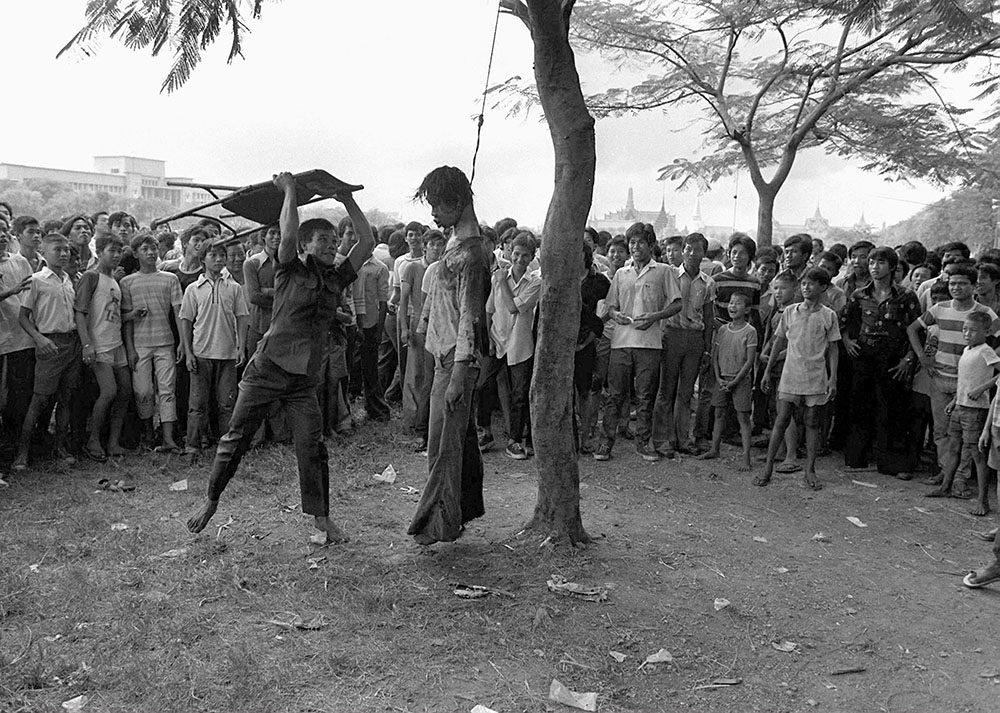The military backed Senate this week blocked a popular progressive candidate from becoming Prime Minister in Thailand. We look back at a particularly troubled year in the Kingdom’s history.

.
Despite its status as a mecca for tourists, Thailand always has an undercurrent of political turmoil, violence, and corruption. The country has always been run by a tight knitted group of bureaucrats, princes, generals, and businessmen, who were reactionary against any slight challenge to their power. As a result, there have been 18 coups and 18 constitutions since 1932 in Thailand, each one staged to thwart the progressive forces from coming to power.
In late 1973, a popular uprising led to the end of the military dictatorship of Field Marshall Thanom. The king invited the chancellor of Thammasat University, a leading jurist, to form an interim government. However, democracy did not take root, and three years later, when Thanom returned from his exile, further student led uprising broke out. Popular refrains still levied against students and activists — of them being communist and anti royalist — were uttered and extremely violent suppression began.
On the night of October 5th 1976, five thousand students were gathered overnight at Thammasat to protest the return of Thanom. At 5:30 AM, a bomb was fired into the Thammasat grounds and shootings began. By 7:30 AM, the campus gates are smashed open, and paramilitary groups and radicalized right-wing protestors stormed the campus. Many died from police gunshots; others were lynched by the crowd, stakes thrust through their dead bodies and women stripped naked with stakes thrust through their breast or sexual organs.
Neal Ulevich, who was covering the protests for AP remembered:
The students had surrendered — a few were able to flee. The paramilitaries made them lie down on the ground. At that point I decided it was nearly over, and to leave before someone demanded my film. I moved to the campus gate. I could see commotion there. I worked my way through it and took a few photos — one, of two policemen escorting a student off campus as he was sucker-punched in the face by a rightist.
Then I saw crowds milling about two trees in Sanam Luang. Among those in the chaos at the gate was an elderly German tourist with an 8mm movie camera, apparently from the Royal Hotel across Sanam Luang. I screamed at him to leave before he was killed. He seemed to be having a good time and ignored me. At the first of the trees, I saw the chair/hanged student. I stayed a moment to see if anyone was looking at me. Then I made a few frames and walked over to the other tree, where another student was hanged. I made a few frames. After that I walked toward the hotel and hailed a taxi. Both hanged students were dead by the time I saw them.
I returned to the AP bureau desperate to have the darkroom tech develop the film and get the first of the prints to PTT [Post and Telephone Office] for radio-photo transmission. I was quite sure all international communications would be shut down or censored within a few hours. At that time, we could not send images from the bureau. Photos had to be printed, captioned and filed like a telegram from PTT. At the bureau I gave Denis Gray a quick summary of what I had seen. He was astonished and began questioning me closely. I told him to hold off until my film was developed and printed. He could see the entire photo record at that point; it spoke louder than words, as photos often do. When the film was developed, I selected the chair image and another, captioned them and dispatched them by messenger to the PTT, hoping to beat any closure of communications. Then I went back to work printing more of my pictures and a few by Mangkorn from earlier in the day. When the messenger returned I asked him if the PTT employees had said anything to suggest censorship. He said no, they just commented on the amazing images. That day we sent — as I recall — about 17 images, 12 of mine and the rest by AP Thai photographers.
The follow-up included images of bodies being burned. All the images cleared before the communications switch was turned off. To put things in perspective, sending 17 images was nearly unheard of, for reasons of effort and cost. But this was clearly a story that deserved to have all available resources thrown at it. We sent those images to Tokyo AP, where they were automatically relayed to New York and London AP. In the evening we began to hear that police had raided Thai newspapers seizing film of the events. Foreign agencies were not visited.
The chaos was used to justify a military coup later that same day. The military would insist that the students fired first – something protesters have always denied. Official figures put the death toll at 46, with 167 wounded and more than 3,000 students arrested. Unoffiically, the death toll was over 100. Nobody was held accountable for the atrocity, and the country’s successive governments have shown that they are still highly sensitive to discussion of it.
The photo above it inspired several Thai theatre productions and movies; and has been used in countless satirical internet memes. The word kao-ee, or ‘chair’ itself became a macabre euphemism in Thailand, a warning about what can happen to those with anti-establishment thoughts. Years later, when Thammasat University Drama Club re-enacted the hanging above (with an effigy which alledgedly stood for the then crown prince, the current king) it was accused of lese majeste and even the newspaper The Bangkok Post which re-printed the re-enactment got embroiled in the controversy.
Ulevich won the Pulitzer and World Press Photo Award for the photo. He recalled the irony.
When I won the Pulitzer, the Bangkok papers noted it on page one. They were very proud that a photographer from Bangkok had won the Pulitzer. They didn’t show the pictures.
.

If you like what I do and what I write, or simply wants me to write more, you can support me via Patreon. I had tremendous fun researching and writing Iconic Photos, and the Patreon is a way for this blog to be self-sustaining.
Proceeds mainly go to buying photography reference books and support me on my research (re: paywalled articles, trips to various archives). In addition to monthly addenda posts on Patreon, readers who subscribe on Patreon might have access to a few blog posts early; chance to request topics or to participate in some polls
Even if Patreon isn’t your thing, you can support by re-sharing, or tweeting about the blog or the specific posts on here. Thanks for your continued support! Here is the link: